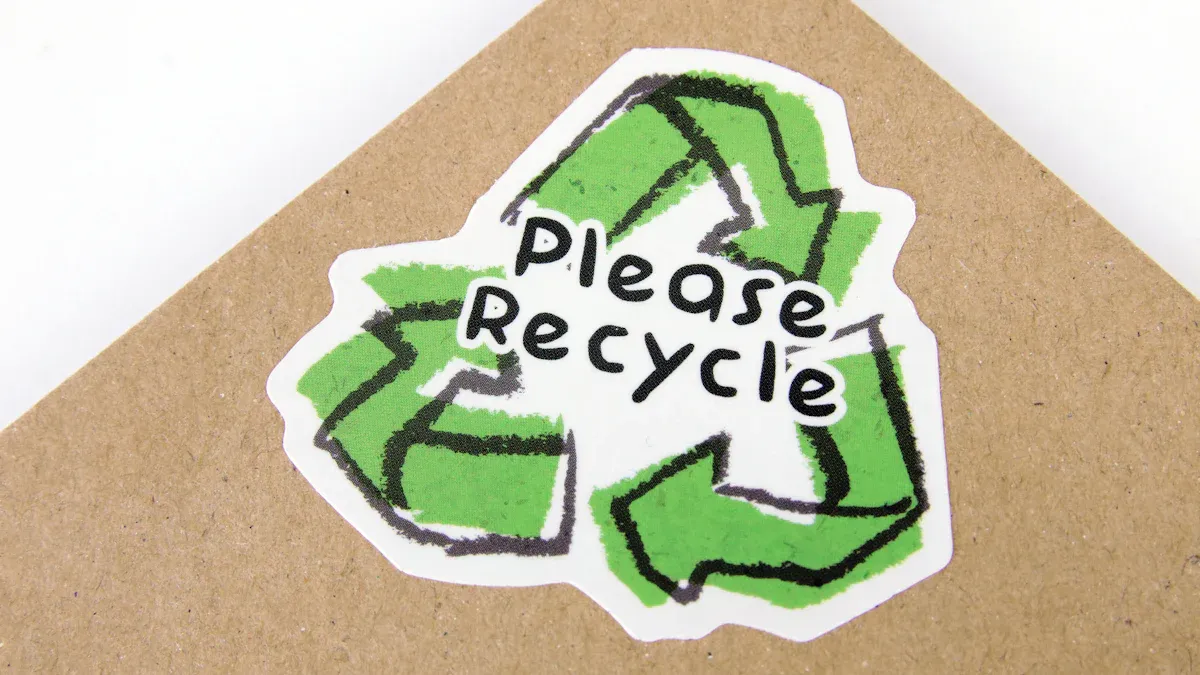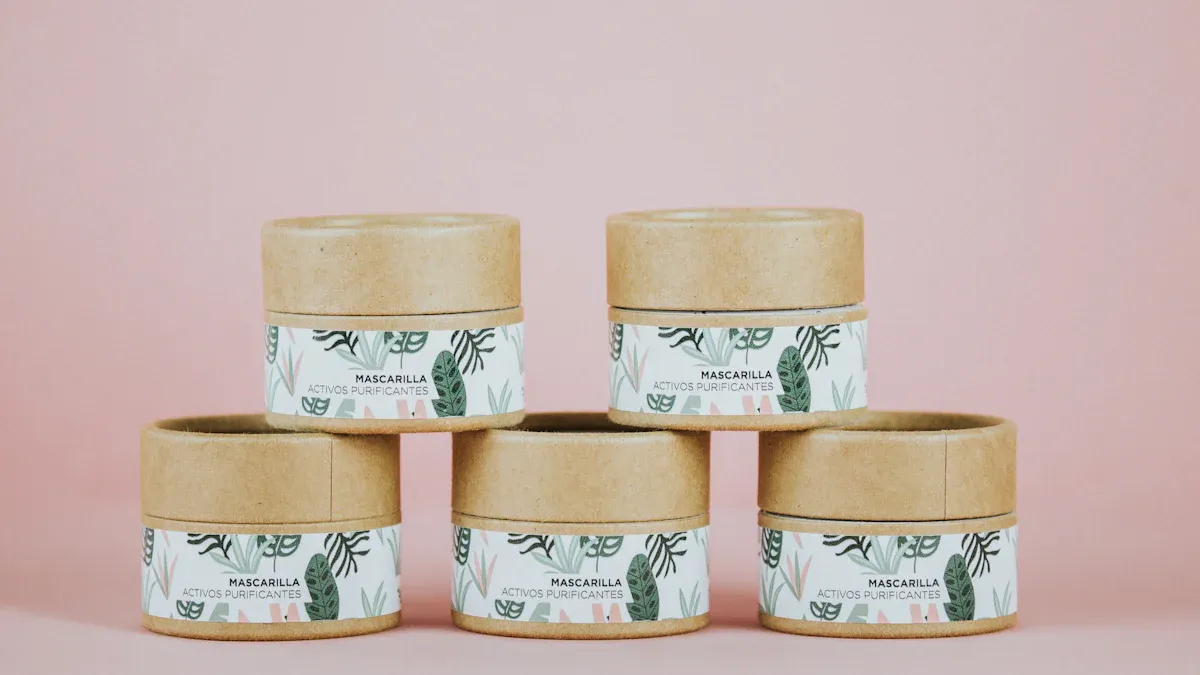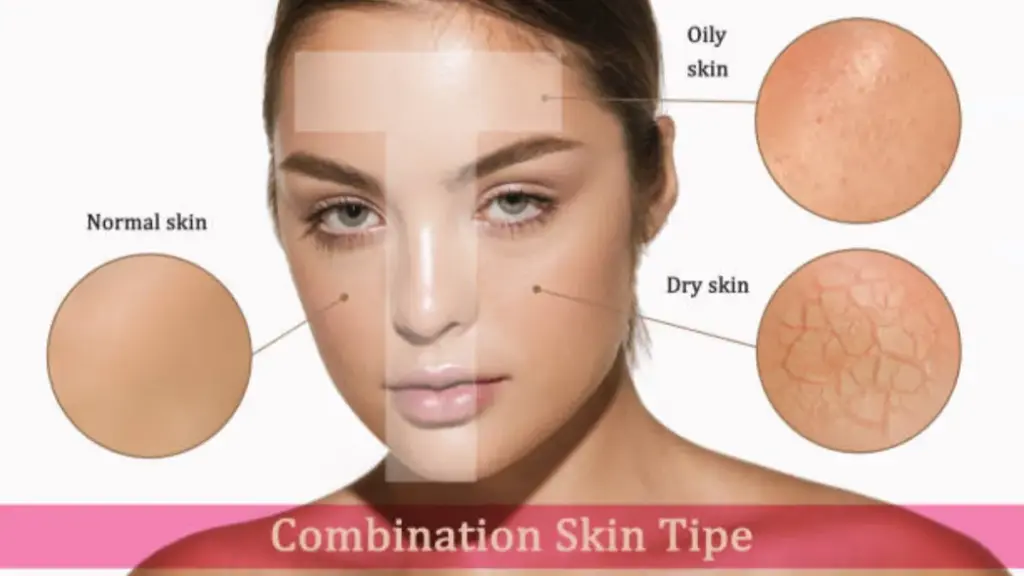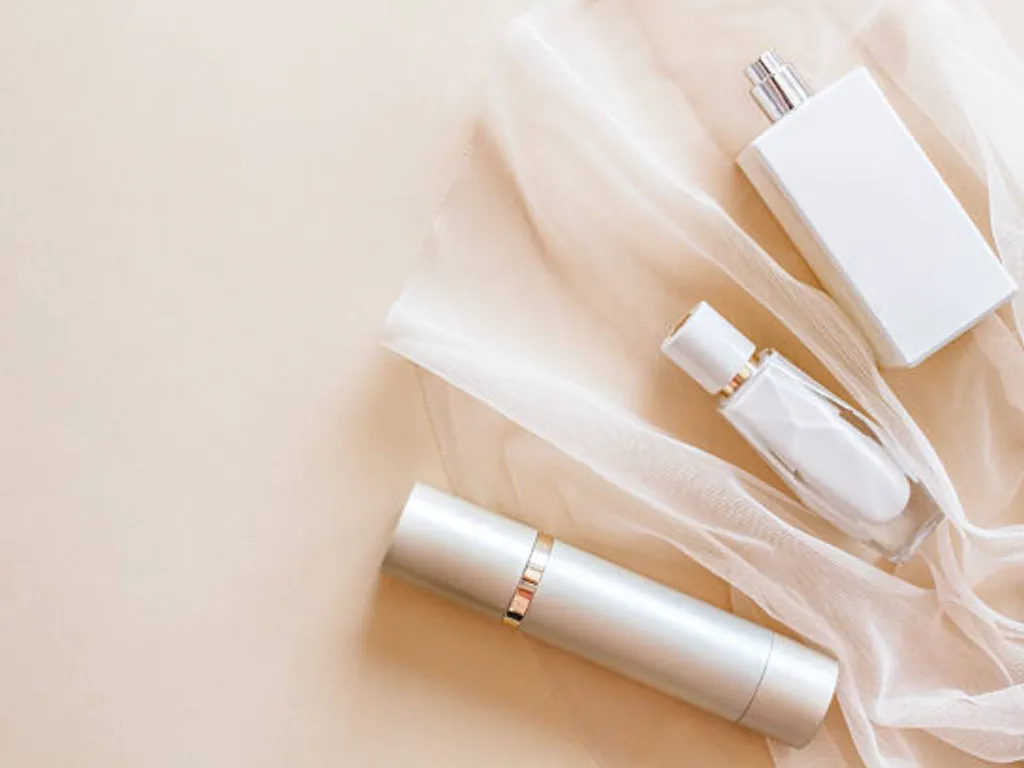
Eco-friendly packaging isn’t just a trend; it’s becoming the standard in cosmetics manufacturing. 왜? 소비자는 변화를 요구하고 있습니다. 사실은, 82% of them are willing to pay more for sustainable options, 그리고 90% of Gen-Z shoppers prioritize it. Beyond consumer preferences, the sustainable packaging market is booming, projected to grow from $292.71 10 억입니다 2024 에게 $423.56 10 억으로 2029. For cosmetics brands, adopting eco-friendly cosmetic packaging isn’t just about meeting demand—it’s about staying competitive in a rapidly evolving industry.
Understanding Eco-Friendly Cosmetic Packaging
What makes packaging eco-friendly?
Eco-friendly cosmetic packaging focuses on reducing environmental impact while maintaining functionality and aesthetics. But what exactly makes packaging eco-friendly? It starts with the materials. Using renewable resources like bamboo or biodegradable paperboard ensures sustainability. Compostable and recyclable materials also play a big role. 예를 들어, brands like Lush have embraced minimal packaging, offering “Naked” products with compostable labels and 100% recycled plastic.
Another key factor is how quickly the materials break down in the environment. Biodegradability testing ensures that packaging doesn’t linger in landfills for decades. 지속 가능한 성분, such as plant-based inks, further enhance eco-friendliness. Aveda, 예를 들어, uses inks derived from renewable sources, making their packaging easier to recycle.
Benefits of sustainable packaging for cosmetics brands
Switching to sustainable packaging offers more than just environmental perks. It can boost your brand’s image and attract eco-conscious consumers. Did you know that ~ 위에 65% of beauty shoppers prioritize eco-friendly packaging when choosing products? By adopting sustainable cosmetic packaging, you’re not just meeting demand—you’re building trust and loyalty.
Sustainability also opens doors to innovation. Refillable packaging, like Kjaer Weis’s durable metal and glass designs, reduces waste while offering a premium feel. 을 더한, sustainable product packaging often leads to cost savings in the long run, especially as governments introduce incentives for greener practices.
Consumer demand and regulatory pressures driving change
Consumers and regulations are reshaping the cosmetics industry. More than 46% of beauty shoppers are willing to pay extra for sustainable products, 그리고 43% specifically look for recyclable packaging. This growing demand pushes brands to rethink their strategies.
Governments are also stepping in. Stricter regulations now encourage the use of greener materials. Many cosmetic brands are responding by replacing single-use plastics with plant-based or recycled alternatives. 사실은, over half of the industry has already made this shift.
The message is clear: embracing eco-friendly cosmetic packaging isn’t optional anymore. It’s a necessity for staying competitive and meeting both consumer and regulatory expectations.
Innovative Materials for Eco-Friendly Packaging

Bamboo: A renewable and biodegradable material
Bamboo is one of the most versatile materials for eco-friendly cosmetic packaging. It’s renewable, 생분해 성, and grows rapidly without the need for fertilizers or pesticides. This makes it a sustainable choice that aligns perfectly with your brand’s commitment to the environment. Bamboo packaging doesn’t just reduce your plastic footprint—it also adds a natural, earthy aesthetic to your products, enhancing their appeal to eco-conscious consumers.
에 의해 adopting bamboo cosmetic packaging, you’re not only contributing to a healthier planet but also meeting the growing demand for sustainable solutions. Bamboo can be composted and recycled, allowing it to biodegrade quickly without leaving harmful residues.
Here’s why bamboo stands out:
It’s lightweight yet durable, making it ideal for cosmetic packaging.
The unique texture of bamboo adds a premium feel to your products.
It’s visually appealing, helping your brand stand out on shelves.
측면 | Details |
|---|---|
환경 적 이점 | Bamboo is biodegradable and renewable, making it a more sustainable option compared to plastic. |
Regulatory Support | Increased regulations favor eco-friendly materials, enhancing the demand for bamboo packaging. |
소비자 수요 | Growing consumer preference for sustainable products drives the market for bamboo packaging. |
Switching to bamboo packaging is a win-win. You reduce environmental impact while boosting your brand’s image as a leader in sustainability.
Glass: Recyclable and luxurious
Glass is the epitome of elegance in sustainable cosmetic packaging. It’s 100% 재활용 가능, meaning it can be reused endlessly without losing its quality or purity. Unlike plastic, which eventually ends up as waste, glass offers a truly circular solution. This makes it a favorite among brands looking to combine luxury with sustainability.
Did you know that in 2017, the U.S. recycled 3 million tons of glass containers? That’s a testament to its effectiveness as a recyclable material. Glass packaging also provides a premium feel, making it perfect for high-end cosmetics like serums, perfumes, and creams.
Why choose glass for your packaging?
It’s non-toxic and doesn’t leach harmful chemicals into your products.
Its transparency allows consumers to see the product inside, adding to its appeal.
Glass is durable and protects delicate formulations from external factors.
If you’re aiming for a luxurious yet eco-friendly design, glass packaging is your go-to solution. It’s sustainable, 재활용 가능, and elevates your brand’s image effortlessly.
Metal: Lightweight and endlessly recyclable
Metal packaging, particularly aluminum, is a game-changer in sustainable cosmetic packaging. 가볍습니다, durable, and endlessly recyclable, making it one of the most eco-friendly options available. Aluminum protects your products effectively while reducing shipping costs due to its low weight.
Aluminum’s recyclability is unmatched. It maintains its quality through the recycling process, ensuring minimal environmental impact. 사실은, the metal cosmetic packaging market is booming, with aluminum leading the way. Valued at $2.87 10 억입니다 2023, it’s expected to reach $3.7 10 억으로 2032.
Here’s why metal packaging works for cosmetics:
It’s versatile and can be molded into various shapes and sizes.
Its lightweight nature reduces transportation emissions.
Aluminum’s sleek finish adds a modern touch to your products.
By choosing metal packaging, you’re investing in a sustainable solution that’s both practical and stylish. It’s the perfect balance of functionality and eco-friendliness.
Biodegradable paperboard: Versatile and sustainable.
Biodegradable paperboard is a game-changer in sustainable cosmetic packaging. 가볍습니다, durable, and easy to customize, making it a versatile option for brands looking to reduce their environmental footprint. You can use it for everything from product boxes to inserts, ensuring your packaging aligns with eco-friendly values.
Why is biodegradable paperboard so popular? For starters, it’s made from renewable resources like wood pulp, which breaks down naturally over time. This means less waste in landfills and a cleaner planet. 을 더한, its adaptability makes it suitable for various industries, including cosmetics, food, and pharmaceuticals.
알고 계 셨나요?? The biodegradable paperboard market is projected to grow from US$ 223.9 10 억입니다 2024 에게 US$ 351 10 억으로 2034, a CAGR of 4.6%. This growth reflects the increasing demand for sustainable packaging solutions across multiple sectors.
Here’s why biodegradable paperboard stands out:
Eco-friendly: It decomposes naturally, 폐기물 및 오염 감소.
Customizable: You can design it to fit your brand’s aesthetic, whether minimalist or bold.
Cost-effective: Its production is often cheaper than alternatives like glass or metal.
Feature | 혜택 |
|---|---|
Renewable Material | Made from wood pulp, ensuring sustainability. |
Versatility | Used in cosmetics, food, and retail packaging. |
Consumer Appeal | Growing preference for biodegradable options drives market growth. |
Switching to biodegradable paperboard isn’t just a smart move for sustainability—it’s a way to connect with eco-conscious consumers who value recyclable and compostable packaging.
Organic innovations: Mycelium, 밀랍, and plant-based options.
Organic materials are redefining sustainable cosmetic packaging. Innovations like mycelium, 밀랍, and plant-based solutions offer exciting alternatives to traditional packaging. These materials are not only eco-friendly but also showcase the creativity and adaptability of sustainable design.
Let’s start with mycelium, a material derived from fungi. It’s 가벼운 중량, sturdy, and fully compostable, making it perfect for eco-friendly packaging. Mycelium grows using agricultural waste, which means it’s produced sustainably without harming the environment. You can mold it into various shapes, making it ideal for cosmetic containers or protective inserts.
재미있는 사실: Research shows mycelium’s versatility extends beyond packaging. It’s being used in electronic circuit boards and even fashion products, proving its potential as a multi-purpose material.
Next up is 밀랍, a natural ingredient that’s gaining traction in sustainable packaging. Beeswax coatings can replace plastic films, offering a biodegradable solution that extends product shelf life. Imagine using beeswax wraps for cosmetic products like soaps or balms—it’s a simple yet effective way to reduce plastic waste.
마지막으로, plant-based options like cornstarch and sugarcane are making waves in the packaging world. These materials are renewable, compostable, and easy to source. They’re perfect for creating lightweight containers or biodegradable labels that align with your brand’s eco-friendly goals.
Here’s why organic innovations matter:
Mycelium: Compostable, 가벼운 중량, and produced sustainably.
Beeswax: Reduces plastic waste while preserving product quality.
Plant-based materials: 재생 가능 및 생분해 성, offering endless possibilities.
Organic packaging solutions don’t just help the planet—they elevate your brand’s image as a leader in sustainability. By adopting these materials, you’re showing your commitment to eco-friendly practices and inspiring others to follow suit.
Practical Steps to Implement Sustainable Packaging
Partnering with eco-friendly suppliers like Oully
Collaborating with the right suppliers is the first step toward adopting sustainable packaging. Companies like Oully specialize in eco-friendly cosmetic packaging and offer tailored solutions to meet your brand’s needs. 10 년이 넘는 경험으로, Oully provides access to renewable materials like bamboo, 유리, and biodegradable paperboard, ensuring your packaging aligns with sustainability goals.
팁: Partnering with suppliers who prioritize sustainability not only simplifies the transition but also ensures compliance with evolving regulations.
Brands like Tay Skincare and Bee You Organics have successfully partnered with suppliers to implement sustainable solutions. Tay Skincare uses refillable bamboo containers, while Bee You Organics opts for reusable tin cans. These partnerships demonstrate how working with eco-conscious suppliers can transform your packaging strategy.
Here’s how you can get started:
Research suppliers with proven expertise in sustainable packaging.
Prioritize those offering customizable options to match your brand identity.
Negotiate contracts that include access to innovative materials like mycelium or plant-based solutions.
By choosing the right supplier, you’ll gain access to cutting-edge materials and reduce your environmental footprint.
Investing in research and development for innovative solutions
Innovation drives sustainability. Investing in research and development (아르 자형&디) allows you to explore new materials and technologies that enhance your packaging’s eco-friendliness. 예를 들어, biodegradable films and lightweighting technologies have already reduced waste and improved recyclability.
메모: The sustainable packaging market is projected to grow significantly, driven by zero-waste measures and advancements in eco-friendly innovations.
Market Aspect | Past Trends (2020–2024) | Future Projections (2025–2035) |
|---|---|---|
Market Growth | Accelerated expansion due to zero-waste initiatives. | |
Material Trends | Demand for biodegradable plastics. | Migration to mono-material and edible packaging. |
Regulatory Environment | Single-use plastic bans and EPR legislation. | Stricter global rules on recycled content. |
소비자 수요 | Preference for low-waste packaging. | Increased demand for refillable options. |
Technology Developments | Advances in biodegradable films. | AI-based smart packaging innovations. |
박사. John Williams, Chief Technical Officer at Aquapak, highlights the importance of transitioning from conventional plastics to sustainable materials. He emphasizes the need for faster adoption of solutions that meet performance requirements and offer viable end-of-life options.
앞서 나가려면, you can:
Allocate a portion of your budget to R&D for sustainable solutions.
Collaborate with universities or research institutions to explore innovative materials.
Test prototypes to ensure functionality and recyclability.
Investing in R&D not only enhances your packaging but also positions your brand as a leader in sustainability.
Designing packaging to minimize waste and maximize recyclability
Smart design is key to reducing waste and improving recyclability. By rethinking your packaging, you can eliminate unnecessary materials and create solutions that are easier to recycle. AI algorithms now play a significant role in optimizing material selection, reducing waste by up to 30%, and suggesting recyclable alternatives.
Callout: AI-driven design practices can help you achieve zero-waste packaging by predicting material performance and making real-time adjustments.
Here are some proven strategies:
Eliminate waste by using mono-material packaging that simplifies recycling.
Circulate materials at their highest value by designing refillable containers.
Regenerate natural systems by incorporating compostable materials like mycelium or beeswax.
Brands like Native have embraced these principles by offering 100% plastic-free containers made entirely from biodegradable paperboard. Their innovative approach showcases how thoughtful design can align with sustainability goals.
To maximize recyclability:
Use plant-based inks and adhesives that don’t interfere with recycling processes.
Incorporate clear labeling to guide consumers on proper disposal methods.
Test your packaging with AI tools to ensure it meets recyclability standards.
By focusing on design, you’ll create packaging that minimizes waste, maximizes recyclability, and resonates with eco-conscious consumers.
Educating consumers on sustainable practices.
Educating your customers about sustainable practices is one of the most impactful steps you can take as a cosmetics brand. 왜? Because informed consumers make better choices, and they’re more likely to support brands that align with their values. By guiding them on how to reduce waste and embrace eco-friendly habits, you’re not just selling a product—you’re building a community of like-minded individuals who care about the planet.
Start by making your packaging part of the conversation. Include clear instructions on how to recycle or dispose of it responsibly. 예를 들어, if you use biodegradable paperboard or glass, let your customers know how to compost or recycle these materials. A simple label like “Recycle Me” or “Compostable Packaging” can go a long way in encouraging action.
You can also use your digital platforms to share tips and tricks. Post videos or infographics on social media showing how to reuse or repurpose your packaging. 예를 들어, a glass jar can become a chic storage container, or a bamboo case can be turned into a jewelry box. These ideas not only reduce waste but also add value to your products.
팁: Host workshops or webinars to teach your audience about zero-waste packaging and sustainable living. This creates a deeper connection with your brand and positions you as a leader in sustainability.
Another effective strategy is to reward eco-friendly behavior. Offer discounts or loyalty points to customers who return empty containers for recycling or refilling. Programs like these not only promote sustainability but also encourage repeat purchases.
마지막으로, don’t underestimate the power of storytelling. Share the journey of your eco-friendly cosmetic packaging—how it’s made, why it’s sustainable, and the impact it has on the environment. When customers see the effort behind your sustainable solutions, they’ll feel more connected to your brand and its mission.
Leveraging certifications to build trust and credibility.
Certifications are like badges of honor for your brand. They show your commitment to sustainability and give your customers confidence in your products. But how do you choose the right ones? And why do they matter so much?
First, certifications bring transparency and accountability to your brand. Labels like FSC (산림 청지기위원회) and Rainforest Alliance prove that your packaging materials meet rigorous environmental standards. When customers see these certifications, they know they can trust your claims.
Second, certifications help you stand out in a crowded market. Think about it—when a customer is choosing between two similar products, they’re more likely to pick the one with a recognizable eco-friendly label. Certifications like Energy Star or Fair Trade act as credible endorsements, making your brand the obvious choice.
메모: Certifications also educate your customers. Labels like Fair Trade explain that your products support ethical practices, while others highlight your commitment to zero-waste packaging or sustainable sourcing.
Here’s a quick breakdown of how certifications can benefit your brand:
Certification Type | 혜택 |
|---|---|
FSC or Rainforest Alliance | Ensures sustainable sourcing of materials, building trust through transparency. |
Energy Star | Differentiates your brand with a credible eco-friendly endorsement. |
Fair Trade | Educates consumers about ethical practices, fostering deeper engagement. |
To leverage certifications effectively, display them prominently on your packaging and marketing materials. Whether it’s a stamp on your product box or a badge on your website, make sure your customers see them. You can also create content explaining what these certifications mean and why they’re important. This not only builds trust but also strengthens your brand’s reputation as a sustainability leader.
Certifications aren’t just about compliance—they’re about connection. They show your customers that you care about the same things they do: the planet, ethical practices, and a sustainable future.
Real-World Applications of Eco-Friendly Packaging

Case studies of successful cosmetics brands
Many cosmetics brands have embraced eco-friendly packaging to reduce their environmental impact and meet consumer demand for eco-conscious products. Their success stories highlight the power of sustainable solutions in transforming the industry.
Lush Cosmetics leads the way with reusable containers and innovative “naked” 제품. 위에 65% of their items are sold without packaging, and their bottles are made from 100% post-consumer plastics.
M.A.C Cosmetics promotes a circular economy by encouraging customers to return empty packages for recycling.
DECIEM collaborates with suppliers to create biodegradable packaging from repurposed paper.
Origins aims for 80% of its packaging to be recyclable or reusable by 2023. They’ve also committed to planting one million trees.
Aveda was the first beauty brand to use 100% post-consumer recycled PET for its packaging, setting a high standard for environmental sustainability.
These brands prove that adopting environmentally friendly materials and practices not only benefits the planet but also builds trust with eco-conscious consumers.
Lessons learned from industry leaders
Industry leaders have shown that sustainability requires bold goals and innovative strategies. Their lessons can guide your brand toward impactful change.
회사 | ESG Target |
|---|---|
The North Face | Use only single-use plastic packaging and 100% responsibly sourced apparel fabrics by 2025. |
에스테 로더 | At least 90% of palm-based ingredients certified as sustainable by 2025. |
Kao Corporation | Carbon zero by 2040 and carbon negative by 2050, transitioning to 100% renewable electric power. |
These examples highlight the importance of setting measurable targets and investing in long-term solutions. 예를 들어, a global beauty company reduced its greenhouse gas emissions by ~ 위에 40% by switching to compostable materials and refillable packaging. This achievement underscores how reducing the environmental impact of packaging can align with broader sustainability goals.
How Oully supports brands in adopting sustainable packaging
Oully makes it easy for cosmetics brands to embrace environmental responsibility. 10 년이 넘는 경험으로, Oully specializes in crafting eco-friendly packaging solutions tailored to your needs. 그들의 fda-, 이소의 뜻, and cGMP-certified facility ensures high-quality production while prioritizing sustainability.
Oully offers a wide range of environmentally friendly materials, including bamboo, 유리, and biodegradable paperboard. They also help brands explore innovative options like compostable packaging and refillable designs. Oully와 파트너십을 맺음, you gain access to cutting-edge technologies and expert guidance to reduce your environmental impact.
팁: Oully’s customizable packaging solutions allow you to align your brand identity with your sustainability goals. Whether you’re looking for zero-waste designs or luxurious eco-friendly packaging, Oully는 당신을 덮었습니다.
With Oully’s support, you can meet consumer demand for eco-conscious products while positioning your brand as a leader in environmental sustainability.
Eco-friendly packaging is more than a trend—it’s a smart move for your cosmetics brand. It helps you stand out, builds trust, and connects with consumers who care about sustainability. 을 더한, the benefits go beyond branding.
72% of shoppers are buying more eco-friendly products than five years ago.
81% plan to purchase even more sustainable options in the next five years.
Paper packaging is seen as the most eco-friendly by 55% of consumers, while plastic ranks the lowest at 77%.
Switching to sustainable packaging doesn’t just help the planet. It creates jobs, boosts the economy, and positions your brand as a leader in innovation. Take action now to make a lasting impact—for your business, your customers, 그리고 환경.
FAQ
What is the most eco-friendly packaging material for cosmetics?
It depends on your needs! Bamboo, 유리, and biodegradable materials like paperboard are all excellent options. Bamboo is lightweight and renewable, while glass offers a luxurious, recyclable choice. 생분해 성 물질은 자연적으로 분해됩니다, 폐기물 감소.
How can I make my cosmetic packaging more sustainable?
Start by choosing renewable or recyclable materials. Partner with eco-friendly suppliers and design packaging that minimizes waste. Educate your customers on proper disposal methods to ensure they recycle or compost your packaging correctly.
Are biodegradable materials safe for cosmetic packaging?
예, they’re safe and effective! Biodegradable materials like paperboard or mycelium protect your products while breaking down naturally. They’re a great way to reduce your environmental impact without compromising quality.
Can sustainable packaging still look luxurious?
전적으로! Materials like glass and bamboo combine sustainability with elegance. You can also customize designs to reflect your brand’s premium aesthetic while staying eco-friendly.
Why should I invest in sustainable packaging for my brand?
Sustainable packaging attracts eco-conscious consumers, meets regulatory requirements, and reduces your environmental footprint. It also positions your brand as a leader in innovation and responsibility, helping you stand out in a competitive market.
















